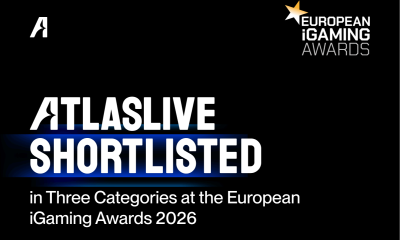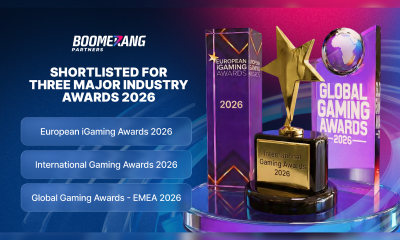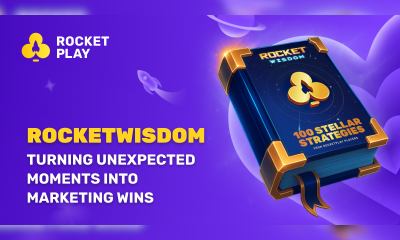Gaming
Outlook on the Mobile Gaming Global Market to 2027 – Players Include Apple, Electronic Arts, Gameloft and Games Inc
The “Global Mobile Gaming Market by Technologies, Platforms, Connectivity Types and Ecosystem Stakeholders 2022 – 2027” report has been added to ResearchAndMarkets’ offering.
This report represents a comprehensive analysis of global mobile gaming opportunities. It provides insights into the mobile gaming business and analysis of current limitations, challenges, and opportunities. The report evaluates current and future mobile gaming technologies, new media, and its dynamics with the mobile gaming business.
The report includes mobile game development studios, publishing companies including local app stores and social networks, gaming economy management companies, mobile gaming business model and drivers, global and gaming business prospects, and mobile network operators.
The report includes extensive user analysis including demographics and preference analysis by game type, device type, connection type and more. It includes comparative analysis by age, gender, income, and spending habits.
Select Report Findings:
- Mobile social game will hold highest market share
- Retail industry will be the fast adopter in branded game segment
- Consumer payment will be the highest market share within gaming service segment
- Gaming Management provider will experience highest CAGR during forecasted period
Today smartphones lead the mobile gaming platform by users but tablets generate higher rates across paid monetization, micro transactions, and advertising. Tablets have started competing substantively with console devices and may overtake them in the near future. Tablets now represent an attractive mid-core gaming platform.
The proliferation of app store and social networking site portals has greatly contributed to the development of the mobile gaming market. Developers can now sell games directly through the app store and can build social communities that lead to greater scope for monetization. Cloud-based publishing has enabled multi-screen publishing and seamless game play across mobile, console and mobile devices that fostered mobile gaming greatly.
Key Topics Covered:
1.0 Executive Summary
2.0 Introduction
2.1 Defining Mobile Gaming
2.2 Mobile Gaming App Development
2.3 Gaming Platform Analysis
2.4 Strategic Market Impact Analysis
2.5 Mobile Gaming Apps Types
2.5.1 Multiplayer Mobile Gaming
2.5.2 Mobile Social Gaming
2.5.3 Mobile Location Based Gaming
2.5.4 Mobile Video Gaming
2.5.5 Mobile Cloud Gaming
2.5.6 Mobile Casual Gaming
2.5.7 Free-to-Play App
2.5.8 Mobile Casino Gaming
2.5.9 Gamification App
2.6 Market Dynamic Analysis
2.6.1 Market Growth Driver Analysis
2.6.2 Market Limitation Analysis
2.7 Regulation and Fraud Analysis
2.7.1 Mobile Game Piracy and Virtual Currency Scam
2.7.2 Mobile Social Gambling Ban in Japan
2.7.3 Geographic Implication of Antipiracy Law
2.7.3.1 Japan
2.7.3.2 Russia
2.7.3.3 China
2.7.4 Zynga with PrivacyVille
2.7.5 Cyber Criminal Attack on Mobile Social Game
2.7.6 In-Game Scam Debate in Mobile Social Game
2.7.7 Open Web to Save DMCA: MiniMega vs. TomKid Game
2.7.8 RMT and Gold Farming Regulation
2.7.9 Offshore Opportunity in Asia
2.8 Value Chain Analysis
2.8.1 Mobile Game Developer
2.8.2 Mobile Game Publisher and Service Aggregators
2.8.3 Sales Channel and Platform Providers
2.8.4 Telecom Operators
2.8.5 Hardware Manufacturer
2.8.6 New Entrants Role
2.8.6.1 Technical and Legal Role of Technology Provider
2.8.6.2 Virtual Goods and Currency Provider Role
2.8.6.3 Micro Transaction Solution Provider Role
2.9 Cross Platform OTI vs. OTA Distribution and Fragmentation
2.9.1 Major Challenges in Fragmented Distribution
2.10 Monetization Metrics Analysis
2.10.1 Converting Mobile Gaming Metrics to Conversion Funnel
2.10.2 Game Life Cycle and KPI
2.10.3 Gaming Analytics
2.10.4 Viral vs. Retention
2.10.5 Business Monetization Metrics
2.10.6 Brand Monetization Metrics
2.10.7 Game Monetization
2.10.7.1 Crowded Game Store
2.10.7.2 Player retention and Engagement
2.10.7.3 Premium Model
2.10.7.4 Opportunity for Game Maker
2.11 Mobile Social Game Design Framework
2.11.1 F2P Mobile Social Game Design Framework
2.11.2 Benefits for using framework
2.11.3 Nine Dimensions of the Framework
2.11.4 Adding Fun in Game Design
2.11.5 Game Marketing: Role of Apps, Video, Smart TV, and Viral
2.11.5.1 Gaming Apps Marketing
2.11.5.2 Video Marketing
2.11.6 Role of Smart TV and Location Targeting
2.11.7 Importance of Viral
2.12 Mobile Social Gamer Engagement Panorama
2.12.1 First 3 Days Dilemma
2.12.2 7 day + Dilemma
2.12.3 Rising Mobile Gaming Engagement
2.12.4 Blending game science with art
2.12.5 Empathy Game: New Wave of Engagement
2.13 Business Model Analysis
2.13.1 Key Mobile Gaming Strategies
2.13.2 Revenue Sources and Cost Items
2.13.3 Trendy Business Model
2.13.3.1 Virtual Items and Micro Transaction
2.13.3.2 In-Game Ad / Branded Games
2.13.3.3 Subscription/Bundle Pack with Virtual Items Trading
2.13.3.4 In-Game Ad / Branded Game with In-Store Benefits
2.13.3.5 Premium Game with In-Store Benefits
2.13.3.6 Casino / Club Gambling Model
2.13.3.7 User Generated Model
2.13.3.8 Gamification Centric Model
2.13.4 Tips for Economic and Gamification in Business Model
2.13.4.1 Free entertainment illusion
2.13.4.2 Never set payment limit for user
2.13.4.3 Focus on detail activities
2.13.4.4 Recruit more players
2.13.4.5 Current Trend in Pricing Model
2.13.5 Advertising Model
2.13.5.1 CPC Advertising Model
2.13.5.2 CPI Advertising Model
2.13.5.3 Profitable CPI
2.13.5.4 Pricing of Virtual Goods
2.13.6 Building Mathematical Model to Set Price
2.13.7 Market Challenge and Game Balancing Method
3.0 Technology and Application Analysis
3.1 Gaming Hardware Analysis
3.2 Gaming Software Analysis
3.3 Gaming Service Analysis
3.4 Gaming Management Provider
3.5 Gaming Technology
3.5.1 Action and Adventure
3.5.2 Social Casino
3.5.3 Sports and Role Playing
3.5.4 Strategy and Brain
3.5.5 Arcade
3.5.6 Other Technologies
3.6 Connectivity Analysis
3.6.1 WiFi
3.6.2 Cellular (4G LTE/5G)
3.6.3 Wimax
3.6.4 Bluetooth/BLE
3.6.5 LPWAN Connectivity
3.7 Mobile Gaming Success Strategy Analysis
3.7.1 Features to Incorporate in Game
3.7.2 Popular vs. New Gaming IP
3.7.3 Mobile Game Production Cost
3.7.4 Successful Gaming IP line Creation
3.7.5 Minimize Marketing and User Acquisition Cost
3.7.6 Use of Monetization Strategies
3.8 Investment Trend Analysis
3.8.1 Second Screen including Mobile Devices and TV
3.8.2 Social vs. Game Network
3.8.3 Gaming Industry Transition and Fragmentation
3.8.4 Gaming Sector and Business Model
3.8.5 Value vs. Volume Regions
3.9 Wearable Gaming
3.9.1 Smartwatch as Wearable Gaming Platform
3.9.1.1 Pervasiveness
3.9.1.2 Interface
3.9.2 Potential Platform Analysis
3.9.2.1 Mind Pirate
3.9.2.2 OBJE (Obscene Interactive)
3.9.2.3 Oculus Rift
3.9.2.4 Sony
3.9.3 Privacy concerns
4.0 Company Analysis
4.1 Mobile Game Developer and Publisher
4.1.1 Activision Blizzard
4.1.2 Alphabet (Google)
4.1.3 Apple
4.1.4 Electronic Arts
4.1.5 Gameloft SE
4.1.6 Games Inc.
4.1.7 Take-Two Interactive Software
4.1.8 Glu Mobile
4.1.9 GungHo Online Entertainment
4.1.10 IBM corporation
4.1.11 InMobi
4.1.12 Kabam Games
4.1.13 MocoSpace
4.1.14 NetEase
4.1.15 Nintendo
4.1.16 Oracle corporation
4.1.17 Rovio Entertainment
4.1.18 Sony Interactive Entertainment
4.1.19 Supercell Oy
4.1.20 Tencent Holdings
4.1.21 The Walt Disney Company
4.1.22 Ubisoft Entertainment SA
4.1.23 Zynga
4.1.24 Halfbrick
4.1.25 Capcom
4.1.26 Namco Bandai
4.1.27 Gamevil (Com2uS)
4.1.28 Zeptolab
4.1.29 Square Enix
4.1.30 Gameprom
4.1.31 Kairosoft
4.1.32 Konami
4.1.33 GREE
4.1.34 DeNA
4.1.35 Sina Weibo
4.1.36 Papaya Mobile
4.1.37 Hungama Games
4.1.38 Anino mobile
4.1.39 Socialpoint
4.1.40 Agate Studio
4.1.41 Renren
4.1.42 Kaixin001
4.1.43 51.Com
4.1.44 Mixi
4.1.45 Cyworld
4.1.46 Bebo
4.1.47 Amazon
4.1.48 Gaia Online
4.1.49 Badoo
4.1.50 Chillingo
4.1.51 KakaoTalk
4.1.52 Line
4.1.53 Wandoujia
4.1.54 Baidu App store
4.1.55 Facebook Games
4.1.56 Slide ME
4.1.57 GetJar
4.1.58 CodeNgo
4.1.59 Apps UK Ltd.
4.1.60 Anzhi
4.1.61 F-Droid
4.1.62 Cydia
4.1.63 Nvidia (Geoforce)
4.1.64 Nook App Store
4.1.65 Taobao App Market
4.1.66 Bemobi International
4.1.67 Mobango
4.1.68 Appitalism
4.1.69 Kongregate
4.1.70 Maopao
4.1.71 Alternative.To
4.1.72 360 Market
4.1.73 Xiaomi App store
4.1.74 One Store Corp.
4.1.75 MTNPlay
4.2 Gaming Service Management Provider
4.2.1 WildTangent
4.2.2 iWin
4.2.3 Twitch.TV
4.2.4 Appia
4.2.5 XSplit
4.3 Carrier Analysis
4.3.1 AT&T
4.3.2 Verizon
4.3.3 T-Mobile USA
4.3.4 Vodafone
4.3.5 EE
4.3.6 Telenor
4.3.7 NTT DoCoMo
4.3.8 KDDI au
4.3.9 China Mobile
4.3.10 China Unicom
4.3.11 China Telecom
4.3.12 Airtel (Bharti)
4.3.13 Vodafone Idea
4.3.14 SK Telecom
4.3.15 Telstra Mobile
4.3.16 Optus Mobile
4.3.17 MTS
4.3.18 Telkomsel
4.3.19 Indosat
4.3.20 Viettel
4.3.21 Globe Telecom
4.3.22 Maxis
4.3.23 SingTel Mobile
4.3.24 AIS
4.3.25 DTAC
4.3.26 Etisalat
4.3.27 Cellcom
5.0 Market Analysis and Forecasts 2022 – 2027
5.1 Mobile Gaming Market 2022 – 2027
5.2 Mobile Gamer 2022 – 2027
5.3 Mobile Gamer: Demography Analysis 2022 – 2027
6.0 Conclusions and Recommendations
Powered by WPeMatico
Battle of the Tribes
POLYTOPIA WORLD CHAMPIONSHIP 2025 BREAKS RECORD PARTICIPATION AS FINALS DRAW CLOSER

Reading Time: 2 minutes
Celebrated strategy game The Battle of Polytopia confirms its first ever World Championships has exceeded expectations with over 10,000 sign-ups in its qualifying rounds. While no stranger to tournaments, previously hosting smaller scale, local tournaments called ‘Polysseums’, developer Midjiwan’s first step into global esports has been met with extreme success. The inclusive esports event has a $10,000 prize pool and will conclude on 6 December 2025, 14:00-21:00.
The finals will take place in front of a live-studio audience, with expert commentary and a chance to peek behind the scenes at Midjiwan itself. First place will receive $4,000, the runner-up will take away $2,000, the third and fourth place finishers will get $1,500, and the fifth and sixth place $500.
The Polytopia World Championship 2025 is being hosted by eSports platform, Challengermode, who Midjiwan has relied on for its monthly local tournaments since 2022. Midjiwan also partnered with Black Molly Entertainment to help organise and manage the event. Black Molly Entertainment have years of experience managing eSports tournaments, with notable events including the Geoguesser World Cup and CS:GO Pinnacle Cup Championship.
Midjiwan has worked closely with its community to ensure engagement is high with each round, building a bespoke ‘Spectator Mode’ into the game so fans can watch each game live through the game itself. In the spectator mode the viewer has visibility of all players simultaneously, with stats on how many cities, technologies, kills and more available for quick access.
Christian Lovstedt, CEO of Midjiwan commented:
“Polytopia has always been about welcoming all kinds of players into the world of 4X strategy. That’s why our championship is open to everyone – not just pros with sponsors. We’ve been thrilled at the amount of interest this tournament received from our community, reaching participation numbers way beyond our expectations. We’re excited to bring the finalists to Stockholm and can’t wait to see the strategies that emerge.”
The Polytopia World Championship 2025 kicked off in September, with its ‘Battle of the Tribes’ qualifying round – weekly battles where players competed to be the best in each of the game’s 12 tribes. After an exciting six weeks, the top player from each tribe faced-off, reducing the qualifiers to six finalists. These six winners are listed down below.
|
Tribe |
Qualifying Player |
|
IMPERIUS |
ArthurL248 |
|
BARDUR |
slimmingboy |
|
OUMAJI |
Dreamlander3000 |
|
HOODRICK |
Theetat |
|
XIN-Xi |
LeLiberateur |
|
LUXIDOOR |
Meisterlampe |
Recaps of each round of the tournament prior to the finals can be watched on the official Battle of Polytopia YouTube channel.
-
Part 1: Polytopia World Championship 1st Qualifiers Wrap-Up – BARDUR, IMPERIUS, KICKOO, ZEBASI
-
Part 2: Qualifiers Wrap-Up – Oumaji Hoodrick Yadakk & Quetzali – World Champoinship 2025
-
Part 3: Final Qualifiers Wrap-Up – Xin-Xi, Luxidoor, Ai-Mo & Vengir – World Championship 2025
-
Face-off stream: https://youtube.com/live/GnU6mWPoJiY?feature=share
To watch the finals live on December 6,visit here: https://polytopia.io/stream/
To stay up to date on the Polytopia World Championship 2025, or purchase one of the limited tickets for the live event, visit the official website or join the Official Polytopia Discord.
The post POLYTOPIA WORLD CHAMPIONSHIP 2025 BREAKS RECORD PARTICIPATION AS FINALS DRAW CLOSER appeared first on European Gaming Industry News.
Betiator
Delasport Unveils a Crash Game for Sports Betting

Reading Time: 2 minutes
Leading iGaming supplier Delasport teases a one-of-a-kind sports betting crash game called Betiator – a new in-play experience that merges live sports with the tension and excitement of crash games.
Inspired by the groundbreaking casino genre, the company once again pushes the whole industry to a new phase in evolution by allowing sports bettors to play in the same easy and fun way as fellow casino players. Crash games are booming in the casino world, showing that players crave more emotional, fast, and visually engaging formats – and Betiator brings that same adrenaline-charged energy to the sportsbook.
It changes the scene by introducing a truly innovative way to bet on sports, keeping players at the edge of their seats during the game. Designed to excite both sports bettors and casino players, it marks a defining moment for innovation.
This product comes as a logical next step in the evolution of live betting and the company’s goal to disrupt the iGaming industry. It demonstrates Delasport’s successful commitment to unique innovation: a strategy they call “Going Beyond Content” –building on the success of products and features like SuperPot, My Sportsbook, My Combo, Double My Winnings, and many more.
“Sports bettors deserve the same level of innovation and excitement that casino players get all the time,” Delasport’s CEO Oren Cohen Shwartz says. “At Delasport we’re taking the whole game to a new playing field with Betiator. Live betting won’t feel outdated anymore as we’re bringing in the thrill of the casino to sports betting.”
While details about Betiator remain under wraps for now, Delasport promises a completely new way to experience live sports. Operators and partners eager to see it in action can schedule exclusive demos and discover more at ICE Barcelona 2026, taking place January 19–21, where Betiator will make its official debut.
The post Delasport Unveils a Crash Game for Sports Betting appeared first on European Gaming Industry News.
Central Europe
game’s 2026 industry barometer – the mood in the German games industry is beginning to brighten

Reading Time: 2 minutes
The post game’s 2026 industry barometer – the mood in the German games industry is beginning to brighten appeared first on European Gaming Industry News.
-

 Andrew Jackson6 days ago
Andrew Jackson6 days agoScientific Games Adds to Information and Security Management Certifications, Continues Setting Global Industry Gold Standard
-

 Eastern Europe6 days ago
Eastern Europe6 days agoHIGHLIGHT GAMES LIVE IN ROMANIA WITH FORTUNA ENTERTAINMENT GROUP
-

 Best Solutions for iGaming Industry in Romania 20256 days ago
Best Solutions for iGaming Industry in Romania 20256 days agoSoft2Bet Nominated for Best Solutions for iGaming Industry in Romania 2025
-

 Australia6 days ago
Australia6 days agoBetMakers Signs Multi-Year Agreement to Launch CrownBet
-

 Latest News6 days ago
Latest News6 days agoAtlaslive Shortlisted in Three Categories at the European iGaming Awards 2026
-

 Latest News3 days ago
Latest News3 days agoBoomerang Partners has been included in 3 prestigious industry Awards, which will be presented in January 2026
-

 Balkans5 days ago
Balkans5 days agoBragg Gaming Wins Online Platform of the Year at BEGE Awards 2025
-

 Latest News6 days ago
Latest News6 days agoHow RocketWisdom Turned From An Internal Activity Into a Marketing Case









